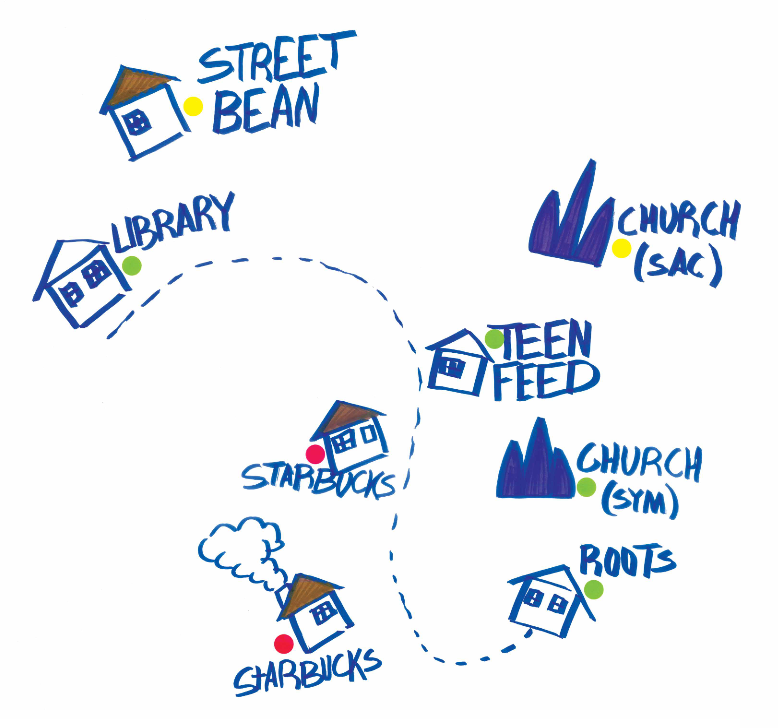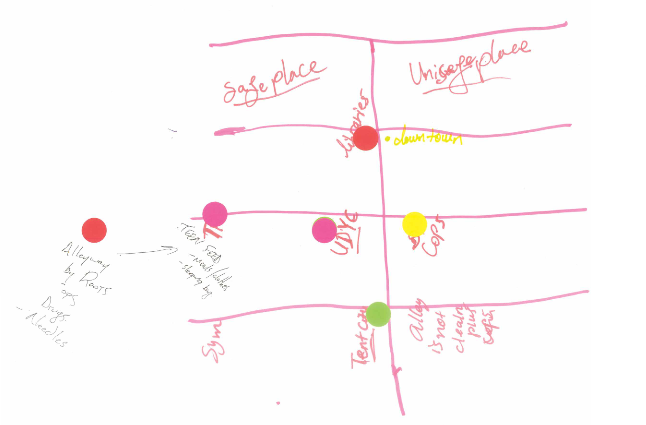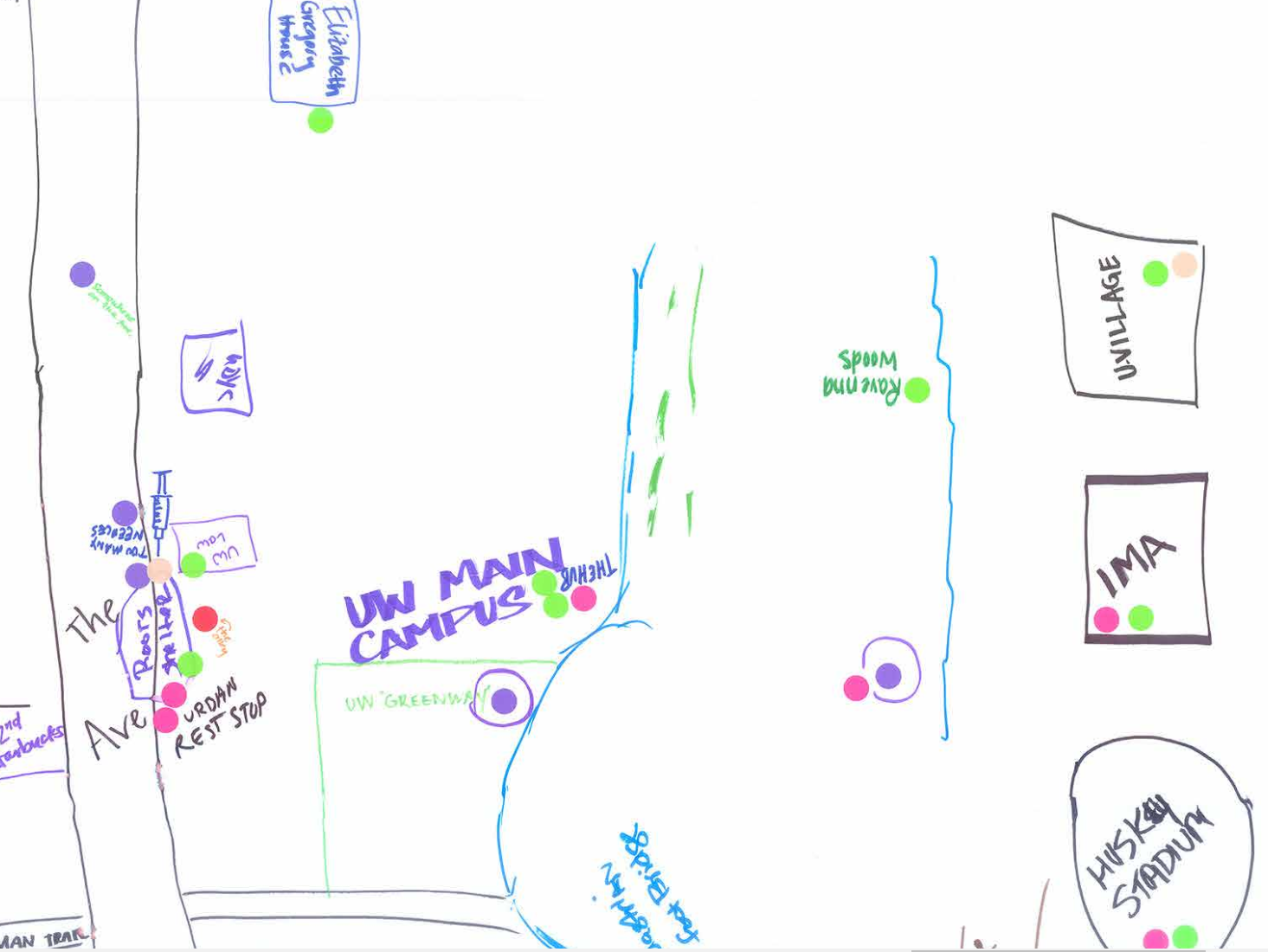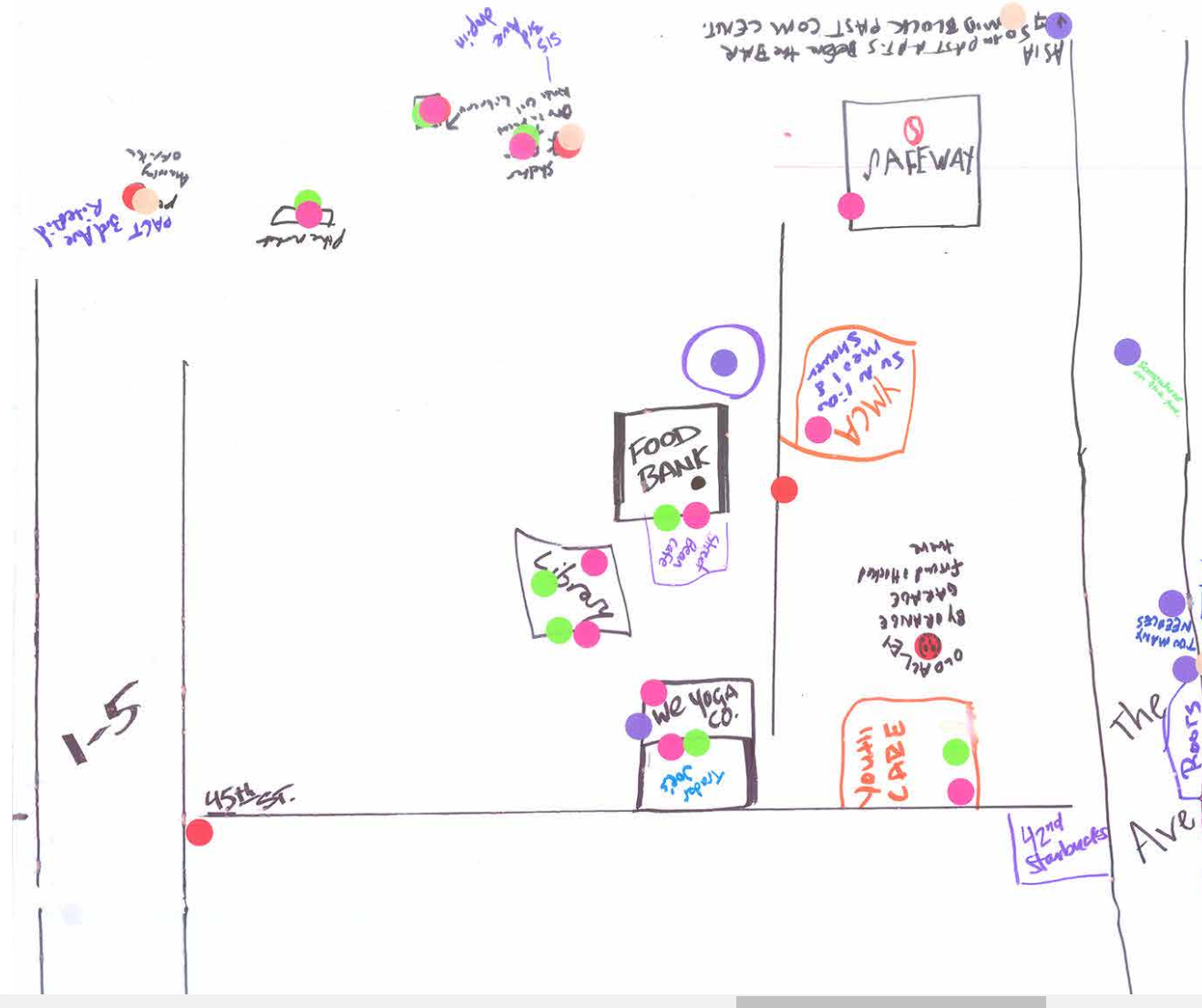Community Maps
Throughout out first year, we sat down with youth and young adults at drop-in spaces, special events, and pop-up cafes to ask them to map out their University District through ‘community mapping’.
With nothing more than a blank sheet of paper, stickers and some markers and colored pencils, each person involved was able to visually show us a small example of what their world looks like. Which places in the U District are health, and which are unhealthy? Which places are safe, and which are unsafe? And finally, where do you think a community cafe like Doorway Cafe should go?
This exercise helps everyone understand a little bit more of the dangers and safe havens that homeless youth and young adults need to navigate each and every day for their safety and health. Below is a small sampling of the community maps we collected. Each marker is an opinion of that specific youth, and not the Doorway Project as a whole.
Interview Quotes
Here are a few key insights and thoughts from our Year 1 interviews with homeless youth and young adults
On A Community Cafe:
“Something that when I walk in is something very open, and you just feel like you’re accepted. Nobody’s gonna judge you for being homeless, or for not having enough money to do this or that; just like something that’s… a safe haven.”
If there were a café space in the U District, can you imagine what it might look like?
For a café… It’s really important that it be a place of mutual support. Like the reason I like the Recovery Café up in Everett so much, is that they accept donations. Everybody can help. So if you have something, you can donate, or like anyone can come in and cook, and then suddenly you’re cooking together and meeting new people and networking. Up there it’s volunteer run. Volunteering makes me feel like I’m not worthless.
I’d like a place to work with me to help me plan things out and work on my goals. I would like it to be a place where I can meet people who can input common sense and work with me to build my ideas. It should be a place of support.
Like not just the helpers and the people who need help, but a community built on mentorship with mentors, mentees, and people to guide the process, because giving back is really important to me and it keeps me engaged when I feel like I can give back too.
I like programs with like, a community soup. Everybody can bring something to put in, can come cook, or clean. What is critical is lowering barriers. So you don’t have to have a program that makes it really difficult to just drop in and help. I mean, some standards are good, like no moldy food, but just making sure that the barriers are low for people to participate.
I would really like to option to eat healthy. An open kitchen would be great. Not having everything be programmed, and rigid. Have open options. Avoid having an “us” vs. “them” mentality.
And it’s good to have resources that are outside “the system”. Like have you heard of tool libraries? The shelters and centers almost never know about stuff like that, but those can be really useful. Or having an open mic. Again, low barriers are key.
A spot where people can come and be themselves. TeenFeed, that’s what we provide. Every Wednesday we have this drop-in where people can come in, people can pick what food they want, and we have Netflix on, we have free wifi, and people can decide between like Futurama, Rick and Morty, or “what do you guys want to watch?”
And for two hours they can just come, be theirselves, talk to a case manager there who helps out a lot. And people talk to her if they need anything. So yeah. That’s how I envision it.
Well, having like on-site mental health. Very big. Lots of cubicles, for privacy. Services like (a mental health professional), and other information.”
Um, I’d like to find simplicity. You know, a simple design. Nothing, nothing too homey or, you know, cluttered. Warm space. Very simple design. In terms of design you know, warm colors, vanilla, that seems, that’s not something I, uh, try to look for in any space. But that would just hit my comfort zone.
Probably use it to definitely look for jobs; a place to warm up, and you know maybe if I do get a job and housing, just a place to go and see my friends. If they’re hanging out there; just a place to… hang.
Something that when I walk in is something very open, and you just feel like you’re accepted. Nobody’s gonna judge you for being homeless, or for not having enough money to do this or that; just like something that’s… a safe haven.
I’m a book reader, so definitely something to do with reading; maybe like a little book nook, or a little loan bookshelf where people can like put books in, the community can like, if the community has any spare books they can donate them there, libraries can donate if they’re getting rid of like all the withdrawals they do, where they sell them they can donate them to us, and maybe people could come and do music. Like an open mic night! I’d definitely go to open mic night. Or like karaoke night? That’s definitely something I would probably do.
(My hopes and dreams are) that it works successfully, that nobody’s gonna trash it or give it a bad name, ‘cuz I mean, a lot of bad things are associated with homelessness. People give it a bad name when it’s like, “uh, that’s for homeless people.” You know, hopefully give it a positive name within the community.
On Safety:
“What places in the U District do you consider to be safe?”
Well Sanctuary Art Center is safe. UDYC is safe. The Teen Feed office and like a lot of the places I go are safe. Like they always make sure everyone is comfortable, like if there’s needles or anything we will notify them immediately to get that issue taken care of. Like when I was going to the library I even noticed they had a beehive outside.
The needle exchange, TeenFeed, and Roots. Yeah, and the campus.
Street Youth Ministries is probably the safest. It’s a good place where it’s safe and I can relax. Teen Feed is okay, sometimes there are fights, but they usually break them up on their own, rather than calling the cops. Unity Museum is safe, and so is Starbucks.
“What places are unsafe for you?”
Whenever you speak of safe, in the U District, you have to speak of time. Cause there’s one or two spots that are safe at certain times, and then at certain times they’re not. So like, Jack in the Box parking lot, safe all day. Yeah, probably like 1am, 2am, probably not so safe. Uh, 45th street by American Apparel, safe all night. In the daytime, probably like around 1 or 2, lunchtime, probably not so safe…Just anything that could happen. Your stuff gets stolen, you know. Yeah, those are opportunity places.
Uh, unsafe? Most cafes. They uh, I mean, you don’t feel unsafe, but they will kick you out. And that kind of like, takes a toll on your day. It’s like yeah, you know I got a job, trying to make money. Today I don’t have money. Can’t buy anything. But even if I did have money, I don’t want to buy things every day. I don’t want to buy coffee every day. I want to save.
(“Places you try and avoid?”) Um, I wouldn’t say I try to avoid it, because it’s my job to deal with the U District. But I feel like anywhere can be unsafe, no matter where you go, so I mean the needle exchange can be unsafe if you have the right person in there. So I mean yes, there’s places that are unsafe, but everywhere is. I think the most unsafe place though is the Ave. Because you don’t know who’s walking on the Ave. And I didn’t know there’s as much help there is in the U District. ‘Cuz like U dub is not like you’re normal college, it’s a top school, and it’s like it should be yuppyville, but actually it’s funny—nurses from UW started TeenFeed.
